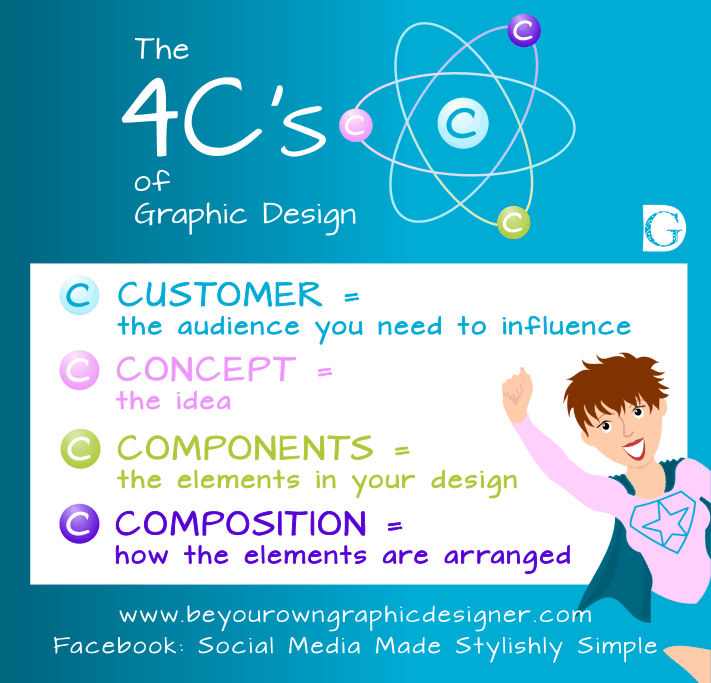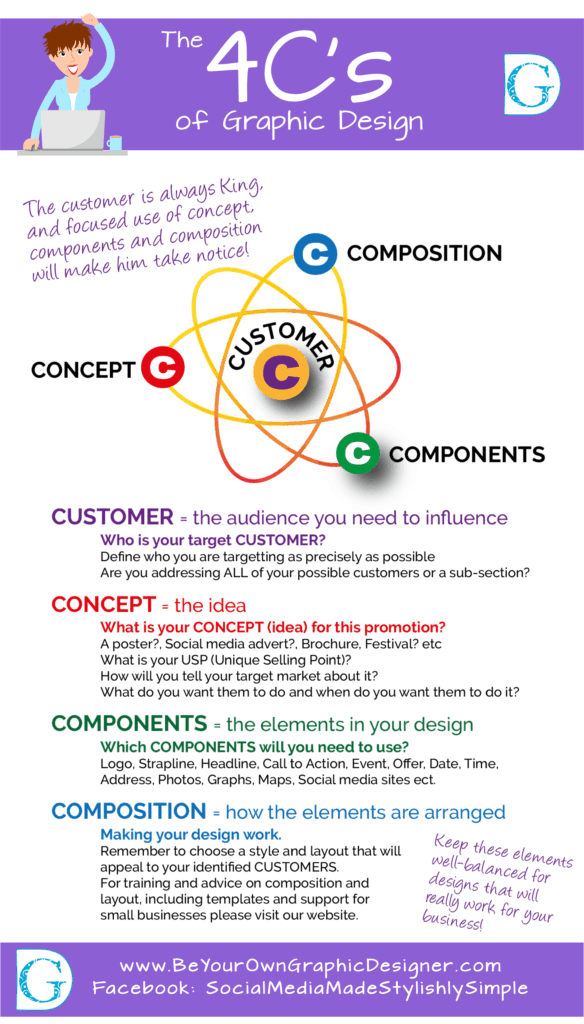The 4C’s of Graphic Design
The 4C’s of graphic design are usually the first thing you learn as a graphic designer. We thought it would be useful to share these, and how to use them, with you on your journey to be your own graphic designer.

But first a story! From when she was a very little girl, Sammy loved packaging! Weird we know. Her mum says she learned to read by looking at labels on cereal packets, ketchup bottles and leaflets that came through the door!
She wanted to design boxes and logos that people would see in shops and buy so when she left school, she went to college to learn to become a graphic designer.
What an eye-opener!
She had never really understood why some designs really worked and some, well, just didn’t… but now she was learning the rules of graphic design, it all started to fall into place.
 One of the very first things she learned was the 4C’s of Graphic Design: CUSTOMER, CONCEPT, COMPONENTS and COMPOSITION.
One of the very first things she learned was the 4C’s of Graphic Design: CUSTOMER, CONCEPT, COMPONENTS and COMPOSITION.
Even though she’s now been designing for many years, this is a checklist she refers back to all the time, particularly when she’s teaching. It underpins the whole principle of graphic design.
Another revelation was that graphic design is NOT about being a great artist, nor is it about drawing or photography – it’s about CONNECTING WITH CUSTOMERS.
Graphic design is not about being a great artist - it’s about connecting with customers Share on X
You could be the best artist in the world but if you don’t connect with your potential customers, you won’t make sales. And you need sales to stay in business!

Customer
Before you even think of designing anything remember…the Customer is KING!
All graphic design and marketing have to be centred around one person – your target customer.
Defining WHO your target customers are as precisely as possible is key.
Once you have defined them in your mind, try to make them ‘real’.
Whatever you do, avoid the trap of thinking that YOU are your customer. Take the time to ‘get into the head’ of your ideal consumer/client and think of how they’ll react to the images and messages you are sending out. It’ll pay huge dividends if you do.
Concept
Once you have defined your ideal customer, you need to think of a CONCEPT.
This is basically the idea for your promotion – it could be as simple as an A5 flyer or a social media advert to a complete weekend festival (although I don’t recommend this as a beginners project!).
 Now ask yourself some leading questions such as:
Now ask yourself some leading questions such as:
- What is my USP (Unique Selling Point) going to be?
- What is the BEST WAY I can ensure my target market gets to hear about my promotion?
- How am I going to tell them?
- What EXACTLY do I want them to do when they hear about it?
- When do I want them to do it?
Make sure your idea is S.M.A.R.T (Specific, Measurable, Achievable, Relevant and Timely).
Break your big CONCEPT down into a few smaller concepts if you can. Make a list for each one and remember they should all have continuity (look like they are all part of the same ‘set’) for a promotion to work well. For example,
- A leaflet
- poster
- magazine ad
- and a Facebook post with a graphic.
Components
List the things you will need to include in your design to achieve the CONCEPT you outlined above.
If you already have one, remember to use your logo, branding colours and typefaces.
 Include (where appropriate):
Include (where appropriate):
- Logo
- Headline
- Strapline
- Call to Action
- Event
- Offer
- Date
- Time
- Deadline
- Address
- Social media addresses
- Multiple ways to respond: phone number(s), email.
Composition
NOW you can start to put your design together! Composition is all about putting the different elements of your design together and making it work. This is where it gets creative, and as long as you have gone through the above steps, the design itself becomes quite straight forward to do.
Remember to choose a style and layout that will appeal to the customers you identified. You need to keep your elements well-balanced so your design really works!
There’s help on our How To page or ask us a question by joining our free Facebook Group, Social Media Made Stylishly Simple.
Hope to hear from you soon,
![]()
